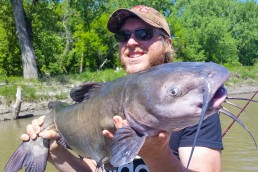Catching Spawning Catfish
SHARE THIS POST
While some anglers dread the catfish spawn and even hang up their rods until it is over, Brad Durick says you just have to know the signs to catch the cats.
Catfish spawn when the water temperature is between 70 and 74 degrees. If the water temperature and weather remain stable once the spawn starts, it can be as short as a couple weeks and you are back in business. Should there be cold fronts and storms that cause swings in water temperature—especially dropping it—the spawn can be a long, drawn-out process.
Poorly coordinated cats
The good news is that not all catfish spawn at the same time. While the spawn is in full swing, there are some late fish that are still in pre-spawn. So, some fish will already be coming out of spawn as the last ones go in. Fish as if you are in a pre-spawn pattern and don’t look back.
The best way to target these fish is working the faster current seams, outside bends where the current swings into holes or outside edge of snags that have good current on them. The pre-spawn fish that have not yet set the nest will be actively feeding. Normally you can catch them without messing with any spawning fish.
Unfortunately, there are those times when most of the fish are on the nest and sitting tight. This is what most anglers think about when the spawn is on. There are ways to catch these catfish and get them back on the nest with no harm, no foul.
Once a female drops her eggs, she moves off to recover and often does not eat for a week or two. It is the males and small fish that are not spawning yet that will be willing participants in this bite.
Fish the flats
The first place to look for spawning catfish is shallow, out-of-the-current flats with snags on them. These spots tend to be tight to the bank and near back eddies where the current is least. They are the easiest spots to find and fish. Keep a keen eye on your lines. In these areas of little current, the fish sometimes pick the bait up and carry it around rather than take it like we are used to. You must be able to see the slightest pickup and be ready to reel down on the fish.
The second place to look is holes along the cut banks of rivers. The fish will back themselves into these holes, so you need to be right on the bank. Using your side imaging, you can see the dips, holes or even snags stuck to the bank that may hold fish. Throw the bait right up to the bank and keep an eye on the lines. If you get too close to a nest, sometimes the male will pick the bait up and move it out to the current seam. You will see the line moving side to side, but the rod will not bend. When this happens, you must reel down or set the hook on the fish to catch it.
Are you enjoying this post?
You can be among the first to get the latest info on where to go, what to use and how to use it!
The last spot is rocks. Catfish love to spawn near rocks. If you can’t seem to catch anything without snagging, you can float your baits along the rock ledges with a bobber. The key is to keep the bait moving slowly enough for a spawning catfish to grab it.
Spawning fish are not all that interested in eating so you have to consider sitting longer on spots to allow the fish to find the bait and decide to eat it. Sometimes an hour sit on a spot can be the answer to catching nicer fish.
Rotate spots with many days between fishing them. I have found that giving spots a four or even five-day rest between fishing is best. If you catch fish one day, there is no guarantee that there will be fish there for the next few days until more filter in.
Conservation
Many frown upon catching catfish during the spawn. It is imperative that all big fish be immediately released back. Once a male protecting the nest is taken home, the nest will be lost. If that same male is put back right away, he will go back to the nest. We have documented this many times here on the Red River, as we have caught the same male protecting the same nest three times. Another time we caught the same tagged male on the same nest twice.
Spawn can be a rough time. You probably will not have the best day of catfishing you have ever had. With some patience and knowing where to go, however, you don’t have to stay home.
Want some more great summer fishing information? Read the June issue of MidWest Outdoors, available the first full week of June at the newsstand or by subscribing on our website.
MWO
SHARE THIS POST
You may also like...
Nothing found.
Did you enjoy this post?
You can be among the first to get the latest info on where to go, what to use and how to use it!
Brad Durick
Captain Brad Durick is a nationally recognized catfish guide, seminar speaker, and author of the books Cracking the Channel Catfish Code and Advanced Catfishing Made Easy. For more information: redrivercatfish.com or facebook.com/braddurickoutdoors.
